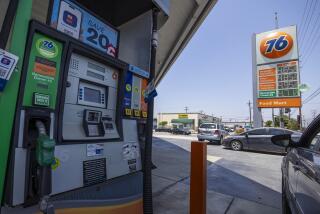Experts ask Congress for more offshore oil oversight as California cleanup continues

Following the O.C. oil spill, a House Natural Resources subcommittee hosts a hearing on the need for stronger federal oversight on offshore drilling.
WASHINGTON — Nearly two weeks after a pipeline ruptured and leaked tens of thousands of gallons of crude oil into the Pacific Ocean, environmental policy experts testified before Congress on Thursday, urging lawmakers to require more federal oversight of aging and abandoned offshore oil platforms and pipelines.
The recent spill off the Orange County coast has put the nation’s oil and gas infrastructure under new scrutiny. Some California lawmakers and environmental advocates have called for a prohibition on all future offshore drilling, while others want to extend a ban to companies already operating in state and federal waters.
In testimony before the House subcommittee on energy and mineral resources, offshore drilling experts painted a bleak picture of the federal government’s ability to ensure that oil and gas companies plug their old wells and dismantle existing platforms and pipelines. They warned that if Congress does not create financial incentives for the industry to pay the full cost of decommissioning its equipment, taxpayers will be stuck with the bill.
The cost could be astronomical. The federal government’s own estimates suggest that between $35 billion and $50 billion would be needed to plug offshore oil and gas wells that are no longer producing — or are no longer profitable. Meanwhile, companies have committed to financing only about $3.7 billion, less than a tenth of the expected cost.
Private industry would never accept the level of risk the federal government has taken on, said Rob Schuwerk, executive director of the Carbon Tracker Initiative, a nonprofit think tank that studies clean energy and greenhouse gas emissions from the fossil fuel industry.
“There are tens of billions of dollars in offshore decommissioning liabilities,” he said. “Operators are neither incentivized to save for these liabilities nor to plan for decommissioning. So they don’t.”
This arrangement is a “bargain deal” for the oil and gas companies, said Rep. Katie Porter (D-Irvine). Once these companies have extracted as much profit from federal waters as possible, “we’re saying that if at the end, you want to hand back the mess to us, we’ll accept it.”
Of the 23 platforms that were installed between the late 1960s and early 1990s in federal waters off Southern California, the Interior Department has scheduled eight to be decommissioned in the coming years. But there are no plans to address the remainder, including Elly, the decades-old platform linked to the recent spill and operated by Long Beach-based Beta Operating Co.
Advocates and lawmakers fear that if this fossil fuel infrastructure is left for years, larger oil companies will continue to sell their aging assets to smaller ones that don’t have the money or inclination to either invest in upgrades or pay for the removal of platforms and pipelines. Some companies have already filed for bankruptcy. The owner of the ruptured pipeline, Memorial Production Partners, filed for bankruptcy under Chapter 11 in early 2017. It emerged several months later as Amplify Energy.
The trend of declining oil production and aging or abandoned infrastructure is also a major problem in the Gulf of Mexico, where government estimates suggest known oil reserves are likely to be depleted by the middle of this century. According to a 2018 study by Louisiana State University researchers, nearly 1,000 existing platforms and other structures may need to be removed from the gulf by 2027.
Federal regulations require companies to remove pipelines no longer in use from the seafloor. Yet, for reasons that are unclear, Interior’s Bureau of Safety and Environmental Enforcement has allowed the industry to leave the vast majority in place. In a recent report, the Government Accountability Office estimated there are 18,000 miles of inactive pipelines in the gulf. The federal government does not know where all of them are or which companies are responsible for them.
Some Republicans tried to sound an upbeat note, pointing out that some abandoned offshore oil platforms have found a new use as man-made reefs that support fish and coral. “We need to make sure we’re not harming the environment here,” said Rep. Tom Tiffany, a Republican from Wisconsin.
But even their witness, marine biology professor Greg Stunz of Texas A&M University, Corpus Christi, acknowledged that while certain structures are beneficial, others should be removed. “It’s not one size fits all,” he said.
Donald Boesch, president emeritus of the University of Maryland’s Center for Environmental Science, and a commissioner on the presidential panel created to study the 2010 Deepwater Horizon spill, warned of dire consequences if industry is allowed to abandon platforms and pipelines in the Pacific and the Gulf of Mexico where they can corrode, suffer damage from storms, and cause navigational problems for ships. Boesch said that after Hurricane Ida struck the Louisiana coast in August, oil began to leak from an abandoned pipeline that had not been sufficiently cleared of residual oil. Separately, Gulf Coast states trying to restore barrier islands have run into an unexpected obstacle — a tangle of old and abandoned pipelines.
Boesch wrote in his prepared remarks that this month’s pipeline leak in California raised questions about the federal government’s policy of relying on monthly surface observations and pressure sensors to detect leaks. Some 15 hours passed after sensors detected a pressure drop before the spill was reported.
“The nation sorely needs a smart strategy for this end game, one that both limits climate change and minimizes the deleterious impacts and risks of the residual infrastructure,” he wrote.
More to Read
Get the L.A. Times Politics newsletter
Deeply reported insights into legislation, politics and policy from Sacramento, Washington and beyond. In your inbox three times per week.
You may occasionally receive promotional content from the Los Angeles Times.











